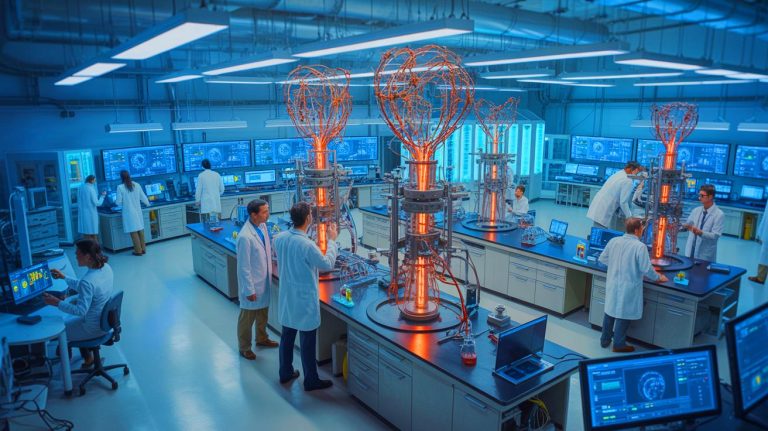| IN A NUTSHELL |
|
Ultra-resistant metals, a dash of AI, and the hope for a revolutionized energy future. The University of Kentucky is betting on a groundbreaking material to make nuclear fusion a commercial reality. On one side, an artificial fusion reactor; on the other, the core of the Sun: two complementary visions of the same energy, balancing human mastery and cosmic power.
Reproducing the Sun’s Core on Earth: The Audacious Bet of the University of Kentucky
The concept of nuclear fusion has always been fascinating. The daring dream of recreating the core of the Sun right here on Earth is a captivating thought. Recently, a significant milestone has been reached by none other than a group of researchers at the University of Kentucky. Through funding of $2.3 million granted by ARPA-E, the U.S. agency dedicated to groundbreaking energy innovations, these scientists are tackling a monumental challenge. Their aim? To design a material that can withstand the extreme conditions inside a fusion reactor.
While nuclear fusion is a dream on paper—clean, virtually infinite, and free from long-lasting radioactive waste—the reality is much harsher. As of now, no material can endure the combination of plasma, intense heat, and radiation for long. In other words, before even producing energy, a real shield must be developed, almost worthy of a superhero.
Creating a Metal Capable of Surviving Nuclear Hell
How are they approaching this task? The team is focusing on an alloy based on tungsten. Known for its thermal resistance, tungsten has its drawbacks, mainly its brittleness. To address this weakness, the researchers are adding chromium, tantalum, and most importantly, conductive ceramic. This ceramic plays an essential role: it dissipates heat and absorbs radiation, protecting the reactor’s walls. It’s not just a matter of robustness, but also thermal engineering.
This combination isn’t random. Quite the opposite. The researchers rely on artificial intelligence to explore thousands of combinations. Through machine learning, they can simulate the performance of each material, akin to a chef perfecting a recipe with each trial. Beth Guiton, a professor in materials science, describes it as a “major technological leap.” Meanwhile, Evelyn Wang, director of ARPA-E, believes this project could bring nuclear fusion closer to commercial reality, much sooner than anticipated.
An Energy Revolution in Progress: 13 Projects, $30 Million, and a Shared Ambition
This project from Kentucky doesn’t exist in isolation. It’s part of a broader national program. No fewer than thirteen similar projects are underway, supported by a total budget of $30 million. Their objective is clear: make fusion stable, sustainable, and above all, profitable.
So, are we on the brink of a historic transformation in how we produce energy? It’s difficult to say at this point. However, with such promising materials and powerful analytical tools, fusion has never seemed so close. Here’s a glimpse into the projects and funding:
| Project | Funding (USD) |
|---|---|
| University of Kentucky | 2.3 million |
| Other National Projects | 27.7 million |
| Total | 30 million |
While the journey to achieving practical nuclear fusion remains fraught with challenges, the steps being taken today are undeniably significant. The University of Kentucky and its counterparts are at the forefront of this potential energy revolution, pushing the boundaries of what’s possible. As we stand on the cusp of what could be a monumental leap forward for energy production, one question remains: How soon will we witness the dawn of a new energy era powered by nuclear fusion?
Did you like it? 4.6/5 (22)






Wow, indestructible reactors? Sounds like something out of a sci-fi movie! 🚀
Is this the end of nuclear meltdowns as we know it?